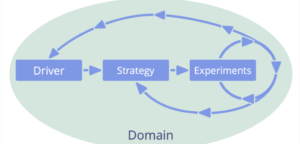I have been reading about common sense framework from Sociocracy 3.0, specially focusing on the Common Sense Framework that they propose. I have a model in my mind that is the Wardley Maps structure: that contains: doctrines, climatic patterns, gameplays and the cycle of strategy. So I cannot avoid the comparison to that model.
Where does Sociocracy 3.0 come from?
Sociocracy 3.0 is a descendent of Gerard Edenburg’s sociocracy (1970’s), a government method based on consent decision making and cybernetic principles. Sociocracy influenced the development of Holacracy (2006/2007) and later (2014) the development of Sociocracy 3.0. Sociocracy 3.0 combines principles of Sociocracy with Lean and Agile.
The 7 principles of Sociocracy 3.0 are:
- Effectiveness
- Consent
- Empiricism
- Continuous improvement
- Equivalence
- Transparency
- Accountability
What are the principles of Common Sense Framework
Sociocracy have principles, some tools (inherited from other methods) and a framework to organize all this. The framework is based on principles (again) and they are summarized in a wheel but I prefer this deck that defines them a little bit:

When I look at these proposed principles, I find them as a mix of doctrines, gameplays and strategy cycle. All of them mixed and ordered in a weird way (please understand that I’m biased).
Each of these principles have a set of “essential patterns” that are the guidance to achieve each one of the goals defined on each card.
Clarify and develop strategy
The card #2 Develop strategy has a set of essential patterns, one of them is “clarify and develop strategy“.
The proposed definition of strategy is: A **strategy** is a high level approach for how people will create value to successfully account for a domain.

To me this definition of strategy is so weak, it does not articulate how you are approaching that strategy and propose a common language and process to define it. What is positive is that it is iterative, and it recognizes that is a learning process itself.
Align flow
This is another essential pattern that is under Develop strategy: In support of continuous flow of value, move decision-making close to where value is created, and align the flow of information accordingly.

There is a definition for all the other “essential patterns”, so you can get the concept quickly. All are defined in a very light way, which is convenient for some of the cases. For instance, the “driver mapping” essential pattern is very well defined and it has a great content itself.
The steps for implementing the common sense framework
Each color have a meaning, and they define each phase of implementation:
- 2 principles for orientation.
- 3 principles for navigation.
- 2 principles for structure.
- 3 principles for transformation.
The order of these four sections make sense to me, but I would agree more in develop the culture since the beginning. I understand that each organization picks their own journey, and I would insist on “doctrines first” approach.
Summary
To me, the common sense framework from sociocracy 3.0 have very good intentions, but it needs to evolve, as some of the practices proposed are not clearly defined and some of the concepts are mixed.
Real life is a spectrum of grey colors, but when you are theorizing about something you have to define black and white clearly, so the listener understand the differences easily. To me there are patterns of behavior that are mixed with patterns of actions, and they should be clearly separated.
Wardley Maps are like MVC pattern (model-view-controller pattern), they separate the concepts clearly. In the case of Wardley Maps, you have: climatic patterns, doctrines and gameplays. This separation provides a clear differentiation of concepts that are applied in an organization and they are linked in different ways.
This simplicity is powerful.